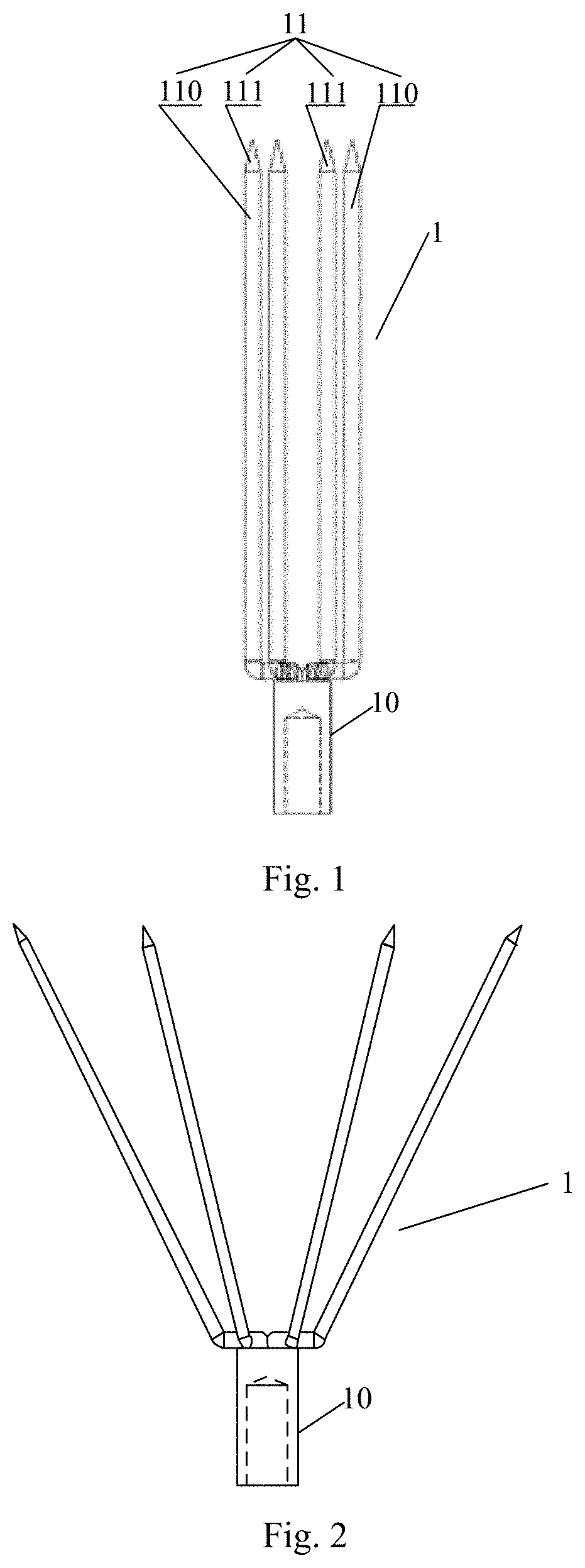Cardiac implantation device and pacing system
a pacing system and implantation device technology, applied in the field of cardiac rhythm medical equipment, can solve the problems of low long-term retrieval success rate, no physical equipment, patent document or literature that can provide an effective solution for atrial pacing, and no leadless pacemaker whose service life has expired, etc., and achieves the effect of convenient implantation, simple structure, and convenient folding and extraction
- Summary
- Abstract
- Description
- Claims
- Application Information
AI Technical Summary
Benefits of technology
Problems solved by technology
Method used
Image
Examples
first embodiment
[0033]the present invention relates to a cardiac implantation device 1, which, as shown in FIGS. 1 to 4, includes: a first connecting member 10, which can be coupled at a first (proximal) end to a pacemaker 2 (here, a leadless pacemaker); and N support struts 11, each of the N support struts having a proximal end coupled to a second (distal) end of the first connecting member 10. At least one of the support struts 11 is provided with an anchor 111 configured to secure the implantation device within the superior vena cava during implantation thereof. Here, each of the support struts 11 may be provided with such an anchor 111. The support struts 11 have respective free distal ends that will elastically yield to forces applied to the N support struts 11 and converge toward an axis of the first connecting member 10. When the forces are removed, the support struts 11 will again radiate away from the axis by their elasticity. N is a natural number greater than or equal to 1. The pacemaker...
second embodiment
[0044]the present invention relates to a cardiac implantation device 1 in which the anchors 111 are of an alternative structure.
[0045]Referring to FIGS. 6 and 7, in this embodiment, the anchors 111 have a barb-like structure with sharp ends, which can pierce into the inner wall of the superior vena cava obliquely downward and thus provide the leadless pacemaker 2 with upward support. When inward forces are applied to the support struts 11, the anchors 111 implemented as barb-like structure can be smoothly retracted and separated from the superior vena cava, without imposing any adverse impact on the retrieval of the cardiac implantation device. This embodiment is not limited to any particular shape or size of the barbs.
[0046]Compared with those of the first embodiment, the barb-like anchors 111 according to second embodiment allow the cardiac implantation device 1 to be more reliably supported and secured to the wall of the superior vena cava and thus enable implantation of the lead...
PUM
 Login to View More
Login to View More Abstract
Description
Claims
Application Information
 Login to View More
Login to View More - R&D
- Intellectual Property
- Life Sciences
- Materials
- Tech Scout
- Unparalleled Data Quality
- Higher Quality Content
- 60% Fewer Hallucinations
Browse by: Latest US Patents, China's latest patents, Technical Efficacy Thesaurus, Application Domain, Technology Topic, Popular Technical Reports.
© 2025 PatSnap. All rights reserved.Legal|Privacy policy|Modern Slavery Act Transparency Statement|Sitemap|About US| Contact US: help@patsnap.com



